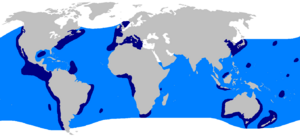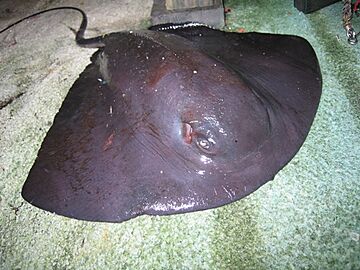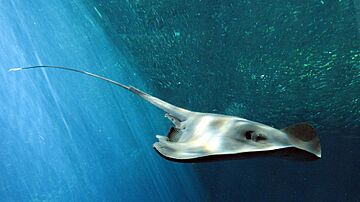Pelagic stingray facts for kids
Quick facts for kids Pelagic stingray |
|
|---|---|
 |
|
| Conservation status | |
| Scientific classification | |
| Genus: |
Pteroplatytrygon
|
| Species: |
violacea
|
 |
|
| Confirmed (dark blue) and possible (light blue) range of the pelagic stingray | |
| Synonyms | |
|
|
The pelagic stingray (Pteroplatytrygon violacea) is a type of stingray. It belongs to the family Dasyatidae and is the only member of its genus. This stingray has a unique wedge-shaped body, which is wider than it is long. It also has pointed teeth, a long, whip-like tail with a very long tail spine, and a uniform violet to blue-green color.
Pelagic stingrays usually grow to about 59 cm (23 in) wide. They live all over the world in waters warmer than 19 °C (66 °F). Unlike most stingrays, which live on the ocean floor, the pelagic stingray lives almost entirely in the open ocean. It is usually found near the surface, down to about 100 m (330 ft) deep. Because it lives in open water, it swims by flapping its fins, much like a bird flies, instead of wiggling its body like other stingrays.
This stingray eats invertebrates (animals without backbones) and bony fishes that swim freely. It actively hunts, using its fins to trap food and move it to its mouth. Pelagic stingrays are aplacental viviparous. This means their babies grow inside the mother, first getting food from a yolk sac, then from a special "uterine milk." They have a short gestation period of 2–4 months. Females can have two litters of 4–13 pups each year.
Fishermen sometimes catch pelagic stingrays by accident. They are not worth much money and are usually thrown back into the ocean. Even though they can give a very painful sting, their numbers seem to be growing. This might be because there are fewer sharks, which are their natural predators. Because they are found worldwide and reproduce quickly, the International Union for Conservation of Nature (IUCN) lists them as a species of Least Concern.
Contents
About the Pelagic Stingray's Name
The pelagic stingray was first described by a French naturalist named Charles Lucien Bonaparte in 1832. He named it Trygon violacea, which comes from the Latin word viola meaning "purple." This name refers to its color.
Later, in 1910, an American zoologist named Henry Weed Fowler placed this stingray in a new group called Pteroplatytrygon. This name comes from Greek words meaning "fin," "broad," and "stingray." Scientists later decided that Pteroplatytrygon should be its own genus. Some scientists still debate if it's different enough from other stingrays in the Dasyatis group.
|
|||||||||||||||||||||||||||
| Family tree of Dasyatidae. |
A study in 2001 looked at the body shapes of different stingrays. It suggested that the pelagic stingray is one of the older, more basic members of its family. It is closely related to a group that includes Pastinachus, Dasyatis, and some Himantura species. Other common names for this stingray are the blue stingray and the violet stingray.
Where Pelagic Stingrays Live
The pelagic stingray lives almost everywhere in the world's warm tropical and warm-temperate ocean waters. This means it lives in the open ocean, far from the coast. You can find it between 52°N and 50°S latitudes.
In the western Atlantic Ocean, it has been seen from the Grand Banks of Newfoundland down to North Carolina, and in the northern Gulf of Mexico. It's also found near Brazil and Uruguay. In the eastern Atlantic, it lives from the North Sea to Madeira, including the Mediterranean Sea. It's also found around Cape Verde and off South Africa.
In the Pacific Ocean, it lives from Japan to Australia and New Zealand. On the other side, it's found from British Columbia to Chile. It also lives around many islands like Hawaii and the Galápagos. While not many reports come from the Indian Ocean, it is known to be common in the southwest part and around Indonesia.
This stingray is special because it lives in the open ocean instead of on the sea floor. It usually stays from the surface down to about 100 m (330 ft) deep. However, it has been caught deeper, at 330–381 m (1,083–1,250 ft), suggesting it sometimes goes closer to the bottom. This species prefers water temperatures above 19 °C (66 °F). It cannot survive if the water temperature drops to 15 °C (59 °F).
Pelagic stingrays migrate seasonally to follow warm water. In the northwestern Atlantic, they stay near the Gulf Stream from December to April. Then they move north to gather near the continental shelf from July to September. A similar journey happens in the Mediterranean. In the Pacific, they seem to spend winter in warm ocean waters near the equator. In spring, they move to higher latitudes and closer to the coast.
What Pelagic Stingrays Look Like
The pelagic stingray has a very thick, wedge-shaped body. Its main body disc is about one-third wider than it is long. The front edges are curved, the outer corners are somewhat sharp, and the back edges are mostly straight. Its snout is short and rounded.
Its eyes are tiny and do not stick out like those of other stingrays. Behind the eyes are the spiracles, which are openings for breathing. The mouth is small and slightly curved. Both male and female pelagic stingrays have single, pointed teeth. Adult males have longer and sharper teeth than adult females.
The tail is long and whip-like, up to twice as long as the body disc. It is thick at the base and gets much thinner towards the end. It has a very long, saw-like spine about one-third to halfway along its length. Sometimes, two spines can be present if a new one grows before the old one falls off.
Young stingrays have smooth skin. As they get older, small bumps appear in the middle of their back. They also develop a row of small thorns along their back, from between their eyes to where the spine starts. This species is a plain dark purple to blue-green on top, including the tail. Its underside is a bit lighter. When caught, it releases a thick black mucus that covers its body. Pelagic stingrays typically grow to 1.3 m (4.3 ft) long and 59 cm (23 in) wide.
How Pelagic Stingrays Live
Because the pelagic stingray lives in the open ocean, it has some unique features compared to stingrays that live on the bottom. Most stingrays swim by wiggling the edges of their bodies. But this species swims by flapping its fins, like an eagle ray. This flapping motion helps it move efficiently in open water. It can also swim backward well, which helps it steer.
Vision seems more important for finding food for the pelagic stingray than for other stingrays. It has fewer electroreceptive sensors (called ampullae of Lorenzini) on its underside than other stingrays. These sensors help them detect electric fields. The pelagic stingray can sense very tiny electric fields from up to 30 cm (12 in) away. It might even be able to sense the small electric fields made by moving seawater.
Pelagic stingrays might separate by sex, with males found in deeper water than females. In aquariums, they can be aggressive towards ocean sunfish (Mola mola), especially when hungry. Large ocean animals like oceanic whitetip sharks, great white sharks, and toothed whales hunt these stingrays. Their dark color helps them blend in with the open ocean. The venom in their tail spine is also very strong, which helps keep other fish away.
What Pelagic Stingrays Eat
The pelagic stingray is an active hunter. It catches prey by wrapping its fins around it, then moving it to its mouth. It is the only stingray where both males and females have pointed teeth, which helps them grab and cut slippery prey.
They eat many different organisms, including:
- crustaceans like amphipods and krill
- molluscs like squid and octopus
- bony fishes like herring and mackerel
- comb jellies and medusae
- polychaete worms
Off California, pelagic stingrays hunt large groups of squid that gather to mate. Off Brazil, they follow groups of Atlantic cutlassfish that are also hunting small schooling fish. Young stingrays eat a lot, about 6–7% of their body weight each day. Adult stingrays eat less, just over 1% of their body weight daily.
Pelagic Stingray Life Cycle and Reproduction
Like other stingrays, the pelagic stingray is aplacental viviparous. This means the baby stingrays grow inside the mother. They first get food from a yolk sac. Later, they get a special "uterine milk" (called histotroph) from the mother. This milk contains proteins and lipids. The mother delivers this milk through tiny threads in her uterus that connect to the baby's breathing openings.
Females have only one working ovary and uterus, on the left side. They can have two litters of babies each year. Mating happens from March to June in the northwestern Atlantic. Females can store sperm inside their bodies for over a year. This allows them to wait for the best conditions to have their young.
The gestation period (how long the babies grow inside the mother) is very short, only 2–4 months. During this time, the babies grow a hundred times bigger!
In the Pacific, females give birth in winter (November to March) in a special nursery area near Central America. In the northwestern Atlantic, birthing also happens in winter when females are in warm southern waters. In the southwestern Atlantic, babies are born in summer (around January) in warmer waters near the equator. However, in the Mediterranean, females give birth in summer before moving to warmer waters.
A litter usually has 4 to 13 pups, with an average of six. The number of pups does not depend on the mother's size. Newborns are about 15–25 cm (5.9–9.8 in) wide. Stingrays in captivity grow faster than those in the wild. Males become ready to reproduce at 37–50 cm (15–20 in) wide and two years old. Females mature at 39–50 cm (15–20 in) wide and three years old. This species can live up to 10–12 years. They are very good at reproducing, and their population can grow by up to 31% each year.
Pelagic Stingrays and Humans
The pelagic stingray is not aggressive and is rarely seen by people because it lives in the open ocean. However, its very long tail spine means you should be extremely careful if you ever encounter one. Its sting can be very painful and needs immediate medical attention. This species has been kept in public aquariums for almost a century.
Fishermen sometimes catch pelagic stingrays by accident when they are fishing for tunas or sharks. These stingrays are usually thrown back into the ocean because they are not worth much money. Many of them die after being caught because fishermen might hit them against the boat to remove them from hooks, which can hurt their mouths and jaws.
Studies in the Pacific suggest that the number of pelagic stingrays has increased since the 1950s. This might be because commercial fishing has reduced the number of their main predators, like sharks and tuna. Because their numbers are not declining, they are found worldwide, and they reproduce quickly, the International Union for Conservation of Nature (IUCN) lists this species as being of Least Concern. In 2018, New Zealand also classified the pelagic stingray as "Not Threatened."
Scientists are researching ways to reduce how many pelagic stingrays are accidentally caught. One idea is to use larger or C-shaped hooks.







